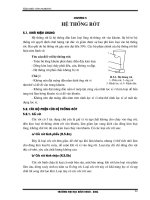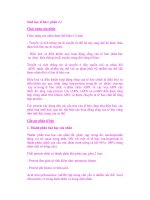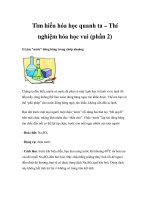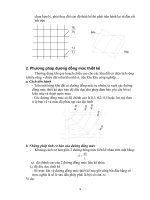phân tích eclectron trong hóa phân tích phần 2 ppsx
Bạn đang xem bản rút gọn của tài liệu. Xem và tải ngay bản đầy đủ của tài liệu tại đây (546.93 KB, 10 trang )
made as both a stabmx7 test and a process ~'sz~able study. In ~]ae farst part of the run, conditions
were held constant ~ 250 °C, 1.48 a1~Pa, 2.0/VZ/g caz-h~ (H~/CO) = 0.67 for 5 m~ss ba]~uces
(about 340 h on stream). Ca~nlvst acdviD" =~.s s~ble during tMs period, wlth tl~e (H.~+CO)
conversions measured in the range 42.6 46.4 ~. Following the stabi]ky test, process conditions mere
va.~ied to determine their e~ect on ~%alys~ activiW a~d selectivi~. The conditions ranged ~rom 235-
265 "C, 1.48-2~6 M~a, 1.0-4.0
HZ/g-cat.h,
(H~/CO) = 0.67-1.0, and 8 mass balances, including
a repeat of the initial conditions, were completed. Chaa~ag of process conditions inczeased the
rate of catalyst deactH~tion, and clm~.ag the repeat of con~tions at 619 h the (H2+CO) conversion
was 35-9 %.
T~ree predpkated iron caxa]yst compositions were selected for resvathesis, on the basis of
overall ~ta]~c performance for the Fisc.~er-Trops~ reason. Approximate]}" 100 g batches of
each o~ tl~e following compositions were prepared, 1~-ing the controlled-pH, continuous predphation
tec.Jamque
tha~ ]~as been
detailed
previously and employed :[or a]] prior ca~.lyst syntI~eses:
100
Fell
C~/0.2 K
100
Fe/3 Cu/0.2 K
100
Fe/5
Cu/4.2K/8 $i0~
~[emeata~ aaa]yses were pe_rformed ~y atO~C a]~sorption spec~osco:py ~or eac~ mat.erjal., a~c~ were
found to be wit~dn acceptable limits.
Me~zI expos~es (dispersions) are an indication of the :fraction of total reduced metal x]aat
is
a~-ailal~le
for
adsorpdon or reaction at
the
su_~ace
of
preclpitate c~'sta~tes.
~.~osu~es w~e
determined for
12
representative catalyst compositions by temperature programmed desorption
o~ adsorbed H~, fol]o~-ing ca]clnaxlon at 300 °C and subsequent reduction in eit~ H~ or C0
at the same Zemperature. Assuming dissodative adsorption of H~, fractional metal expos~es
were ca]cuIated ~rom the to~l amount of desorbed H~ in each case. The observed ~-alues showed
relatively little
~-~-~tion.
Most ~'ere ~ithin the range
H/Fe
= 0.02 to 0.05 and appeared to
be
6
largely" independent of the presence of either copper or potassium promoter or, surprisingly, Si02
and Kl.~Oa supports. Resu]ting exposures ~ere., in genera], somewhat higher for samples reduced
in CO than for those treated in Hz.
Reduction and surface properties of a commercial Rubxchemie iron catalyst were characterized
1Lsing isothermal a~d ~maperat~programmed reduction and X-ray photoelectron s'~troscopic
techniques. Both temperature-programmed and isothermal (300 °C) reduction behaviors of this
material closely resembled those of the 100 Fe/5 Cu/4.~ I~/25 Si02 catalyst thax has been Dmthe-
sized and daa~acterized previously during this inves-tigation. Reduction of the precalcined catalys't
in either H~ or CO occurs in two consecutive steps:
F~03 , Fe304 Fe
Compared to the beh~x'lor of the unsupported 100 Fe/5 Cu/4.2 K composition prepared during
this ~ud~; the presence of Si02 ~;Eni~cant]v decreased the rate of reduction of ~e Rn~chemie
catalyst at 300 °C in both H.~ and CO. In marked contrast to the behavior observed previously for
100 Fe/5 Cu/4.o_ K/25 SiOz, however, XPS measurements indicated ~t reduc~on in H.~ at 300
°C ~ms more effective at producing zero-vahnt surface iron species ~an ~s tre~tmont in CO at
the same
temperat~zre.
Infrared spectroscopic studies have been made to investigate the ¢.ffect of potassium promoter
in influencing the susceptibility of reduced, silica-supported iron to ~oxidation by 02 at 25 °C.
Using 1~0 as a probe adsorbate, these mess~ements have demonstr~l that reoxidaxion occurs
rapidly at ambient temperature in a two-step process that eliminates surface adsorption sites. The
presence of potassium promoter or the use of tfigh (730 °C) reduction temperatures greatly increase
the tendencb" toward reaxid~tion.
We hax~ continued our aaa]ysis of f~xed bed reactor hot trap products collected in pre~oas
runs. Our results for the activation/reduction study runs show the prmeace of at least two chain
7
~ro~'th probabilities (a's) in ~he ll.vdrocarbon distribution. The values fo." low molecul~ products
ran~ed from 0.66 0.74 wl~e for higher products the x-ange was 0.84-0.94. The ana].vsis of the wax
had little effect on the lumped hydror~bon distribution for these rur~, ~-ith on]y minor shifts
between ~he C3-Cn and Cn÷ products.
8
IV. DETAILED DESCRIPTION OF TECHNICAL PROGRESS
T.a-SK 1 E Project Work Plan
The project work plan was completed du.~g the f~st quarter of this project a~d the deUdled
work plan ~-as
submitted
to APCL
T ~-K
2
$1urrT, Catal~ Improvement
2.1.
%Vax
Analysis Results.
We Ims-e continued our wor]~ on ana]y~ng the products collected in the hot
trap
of the f~xed
bed rector systems during previous runs. These results are incorporated into the existing data to
extend the range of carbon uumbers included in the mass balances and selectivity calculations. The
results for sdected zeduction/acti~tion s~udy fixed bed camlys$ tests are summarized in Table 1.
Our aaalysis of the higher molecula~
wdght,
products dearly shows ~a$ at least two chain
grc~-& probabilities (a's) are ~eeded to characterize the product distribution. Anderson-Schulz-
Flory (ASF) plo~s axe shown i~ Figs. 1 and 2 for runs FA-25-2737 a~d FA-25 3077 (;eportcd in
the Tedmical Progress Report for 1 October - 31 December 1987). High methane and C2-C4 )ields
were obtained in ru~ FA-25-2737, wh~e run FA-25-3077 produced large amount of Cn+ products.
Both runs showed product distributions which did not tit the simple, single a, ASF model Huff"
aad Sa::e-'~e/d
(1984)
and Stenger (1985) have discussed mulfiple-o product distn'b~fions, and we
have used the two-a model described by Huff and Satteriidd to represent our data=
(1)
where ra. is the mole fractio~ ofproducts containiag n carbon atoms (hydromrbon and cg'ygesata),
0 is the
fr~tion of tTpe I sites on the cazalyst, aad az and an are the chain growth probab~ities
assodated "with the D'pe I and ~'pe II
~tes, respectively.
The constants appearing in Eq. (1) are obtained in the following manner: at low carbon
number, the product distribution is dominated by the type I site, aad az is calculated from the
9
slope of zhe lo~-line~ ploz in zhe usual manner as ax = exp (slope). Simil~ly, ~ higher carbon
numbers the product distribution is dominated by the ~'pe Ii site, and ezn can be calculated from
the slope at large rz. fl is calculated using these Imown ralues of a, and the best estimate of fl, in
the least squares sense, is given by:
N j j "
. (2)
~-here rn# (1 - ~)a "~-I for the ~'pe X or
IX site, A: is
the maximum carbon number in the
distribution, and zoj is the wd~fing factor associated with carbon number j. The weighting factor
is needed to account for the large range of mole fractions, which typical]y span several orders of
znagrJtude in may one sample; ~thout weighting, ~he estimate of ~ is based almost entirely on the
frst few carbon numbers. The values of~ appearing in Table I were obtained using a weighz given
b.v ~ = e~.
The reduction coRc]~tions effect both the nature of the sizes
(i.e.,
a# and axx) and the number
of sites (or the relative ~tivhy of the sites), ~. The use of H2 reductant, runs FA-25 3237 (250 °C)
and FB-25-322T (280 °C), has little effect on al, but compared to CO reductant (FB-25-0098 and
FA-25 P.96T), H2 decreases
oi1
and increases ~, causing more lower moleculax weight products to be
formed. :M~h xeduction pressure (ruli FA-25-3517) decreased fl siguiflcanfly to 0.68, although this
reduction procedure had a detrimental effect on catalyst stsbZ1ity. The rem~dning CO reductions
resulted in fl ran~ng from 0.81 ~ 0.92. In the presence of H2 reductant,/~ was al~ys ]figh
(0.91-0.92) including the H2+CO reduction (run FB-25-3377).
Deviations bet~'een the model (Eq. I) and zhe experimental daz~ occur for severs] reasons. In
Fig. 1, the negzfive deviations in the Cr-Cx9 range are ca~ed by errors in lifting the parameters
(c~s, c~H, and ~) separsteJy. Overpred/cfion of the mole fractions zzise in the region where the type
I and IX
contributions overlap, while our est/mation technique assumes that the parameters can be
evaluated indJviduaily. T~ese errors are typically small. Negative deviations in the Cv-C~0 mole
10
fr~ctions apparent in Fig. 2 are c,~used by product loss ~ e~-~poration du.ri~g sample handling.
The disparity in the C12 C~0 carbon number products may be due to product losses as well, and
we have also found that errors in this range of carbon n~nbers result from overestimation of the
amounl of ana])~ed wax. By erroneously including more wax than was analyzed into the product
distribution, the mole
fr~ tions
of higher carbon numbers are higher than
expected.
The
result
is z neg~ti~ deviation in the distribution where the organic liq.uid and wax analyses overlLp. An
underestimation of the orga~c ];quid analyzed caused by less than 100 % recover)" in the organic
analysis or sample weight error, should give the same ~,.'pe of deviations.
The addition of the wax analysis results Luto the product distribution had little effect on the
lumped hydrocarbon distributions, which are also shown in Table 1. Only minor shifm in the Cs-
Cll and C1~.+ fractions occurred, due to ¢~he redistribution of Cs-C~I produc~ from the ~x to
the Cs-C~l fraction. The fixed bed reactor ~x is primarily Cz~.+. Small amounts of oxygenates
are usually present in ~e wax, and after analysis, they are reclassified and no longer counted as
hydrocsrbons. This reclassification decreases the frsction of total hydrocarbons formed, which
changes the methane and C2-C4
fractions
r~ight]y.
2.2.
Fixed Bed
Catalyst Studies.
=L.~ ,~o-,~s] fixed bed catalyst process ~-a.dable studies using our standard T~.sling pro-
cedure have been completed. A calcined sample of the Ruhrche.m~e LP 33/81 catalyst has been
te~;~l (~. I'~-S~-13-15) for comparison with previous
tests
of unc~ldned LP 33/81
cat~y~.
A
supported catalys~ conm£uing s nominal 20 parts AltOs/100 psrm Fe has also been ~ed (run
FA-76-096~) to complete the series of AlcOa ~.~t~lys~. An unsupported catalyst containin~ the
same promoter concentrations as the A1~Oz- and SiO~-con~aiag c~lys'~s (~ Cu/4.2 K nominal)
was run to determine the undisguised effect of support on catalys~ performm~ce (run FA-31-I118).
2.2.1. Run FB-99 1348 (Calcined R.uhrchemie LP 33/81).
Six mass baJances ~re performed in run FB-99-1348, and the results are summarized in Table
11
2. This r~m was made to test 11uhrchemie LP 33/81 catalyst after calcination, and the 30/60 mesh
catalyst was reduced with pu~e CO for 22 h at 280 °C prior to exposure to
$)-nthesis
g~s. The
Ruhrdaemie catalyst has a nominal composition of
100
Fe/4 Cu/4 :K/25 Si02 (weight bas~s), wlfi~
is ~ailar to our 100
Fe/5
Cu/4.2 K/25 5i02 catalyst. A test of tuacalcized RuhrchemJe LP 3,3/81
c~tadyst w~s made in run FB-99-3477, reported in the Technical Progress tLeport for I October-31
December
1988,
and selected activity and selectivity
aspects
of
these
two rams are compared in
TabIe 3-
Durimg the first balance at 235 °U, 1.48 .A'irPa, and
2
.~'l/9-cat.h,
the mass closure was low and
the conditions were repeated again during balance 3. The activity of the catalyst between the two
badances was essentially constant, and during balance 3 the (Hz+CO) conversion was 49.1%. At
higher space velocity, 4
Nl/g-c~t.h,
the conversion dropped to 33.8 %. The effect of temperature
at 220, 235, and 250 oC at 2
jVl/g-cat.h and
1.48 MPa, showed the expected inc~ea.se in (H2+CO)
conversion: 25.9 (ba]ance 5~, 49.1 (balance 3), and 60.3 % (balance 4). The conversion at 220 oC
~as lower than expected, and partial deactivation apparently occurred during the test at 250 oC.
Catal.~st deactivation was evident during balance 6 at 235 *C
and
2.96
MPa,
at constant
(P/SV)
as balances 1 and 3. At the kigher pressure, the (H.~+CO) conversion dropped to 36.7 %, while at
the lower press~tre the conversion b-as 49.1 ~.
The
activi~"
of both
calcined mad
uncalcdned
c~tal_vsts ~as very s~mi]ar &~ 235 *C and 2
A'I/g-~t.h, the
calcined catalyst was slightly more active, giving an (H~+CO) conversion of 49.1
% compaxed to the 43.7 % conversion for the uncalcined catalyst. At higher space velocit3" [4
JVl/g-c~t.h)
or ~gher te.mperatalre (250 *C) the calcined and uncalei~ed catalyst
g~.ve
the same
conversions (Table 3). Caxalys't deactivation in ran FB-99 1348 (calcined) during balances 5 and
6 (220 *C, 1.48
MPa
and 235 *C, 2.96
MPa)
caused the (H2+CO) conversions zo be lower than
expected a: these conditions. At the same conditions, the uncaldned catalyst was not deactivated,
thus the lower activity of the calcined catalyst ~s due to deaztk~tion as opposed to calcination.
12
Before deactivation occurred, the calcined cxtaiys~ produced smaller amounts of methane, C4-
C4, and Cs-C~1 products than the uaxcalci~ed cxtalyst. At 235 "C, 2 Nllg-cat-h, the calcined
c~tadyst formed roughly ]~alf the C]~ and C2-C4 products as the Imcalcined cata]3~, 4,3 versus
7.g % (CH4) amcl 17.6 and 36.4 % (C=-C4), while the amo~mt of Cx2+ products iacreased from 29.4
to 61.1%. SLmilaz dLfferences in the selectivity occurred at 235 °C, 4
Nl/f-ctt.h and at 250 "C,
2 JVl/g-cat.h, and are compared in Table 3. We had dif6culties during the "test of the uncalciued
ca~yst with atomic clos=res (the H balance was consistently ]ow) which m~" have some impact
on selecdvi~, ]~owever, large errors in t]~e h vdro'c~rbon distribution are not expected.
The ASF plots for the caldned Ruhrchem]e LP 33/81 catal}~t sho~d a ~rong break in the
distribution at about Cx0, which reflects the tendency
of
the calcined catalyst to produce large
amounts of high mo|ecular weig]~t products. ASF plots for the ba]a=ces a~ 235 and 250 eC (2
.~l/g-cat.h,
1.48 ~fPa) are sho~-n in Figs. 3 and 4. Temperaxu~e had on]y a slight effect on the
parameters, decreasing ~I from 0.64 to 0.63 and ,~ from 0.82 to 0.80, and az~ remained unchanged
at 0.92; the weight % hydro,'~rbon distributions at the two temperaxures are also simUar.
2.2.2.
Run
FA-T6-Og68 (100 Fel5 Cu/4.2 IC./20 .,~120s).
Run FA-76-0958 ~-as the test of 100 Fe/5 Cu/4.2 K/20 -A2203 c~tadyst, and the results of the
six ms.~s b~'.~ ces performed are summarized in Tab,: 4. The catalyst ~.s ground So 30/60 mesh
before charging the reactor, a~d reduced using CO a~ 280 °C for 12 h-'During the fu~t t~ balances,
st 235 ~C, 1.48
.~'Pa,
2 (balance 1) and 4
~l/9 cat-h
(ba2a~ce 2), the (H~+CO) contortions were
68.3 and 35.3 %, increasing to 73.4 % in balance 3 at 250 "C and 2 Arl/9-~t.h. The convenioas are
lower :ha~ tIxe conversions obtained using the 8 parts AI~ O~ catalyst (r~n FA-73-0828, reported
in the Technical Progress Report for 1 3anua.W - 31 .March 1988). The conversions obtained are
b.igl~er than or comparable to the conve~ons using 25 parts SiO.~: 55.0 (balance 1), 38.5 (balance 2),
and 67.6 ~0 (baiance 3) which were ru~ at the same nominai conditions as the alumina-containing
c~taJys~.
13
C~t~lyst deacti~ttion occurzed before the fourth balance at 220 °C, 2
~.I/g-cat-h. The
(H2-i-CO) con~'ersiou obtained duzing this balance =~.s lower than e.x'pected, 22.1% ~s compared to
31.1% for the silica containing catalyst (25 pa.~s Si02) and 31.7 % for the 8 parts Al20a catalyst.
A repeat of the conditions of balance 1 in balance 5 showed that the (H2@CO) conversion had
dropped from the ordinal 68.3 % conversion to onIy 31.5 % over a 96 h time interval. Balance 6
was made at ~gh p~ssure, 2.95
MPa,
at constant
(P/bV) as
balances 1 and 5. The (H2+CO)
~'as 30.5 %, which is comparable to the balance 5 conversion, thus the t5g~ pressure did not ,~,trther
dea~:t]~te the c~talyst.
This catalyst ~'as selective towards tdg]~ molec~az weight products, with s maximum of 61.9
C1~-+ products at 235 °C, 4
.~'l/g-cat.~ in
balance 2. The space ve]ochy had little eiTect on
selec6vi~- as the wright ~ hydrocarbon distribution and the oleftn/p~ ratios were comparable
between balances 1 and 2 (2 and 4 N'l/g-c~ h, respectively). Higher temperature (250 ~C, balance
3) Lucreaxed the Wce~tages of CH4, C.~-C4, and Cb-Cz~ producus as is normally expected, from
3.72, 16.6, and 19.2 % (235 °C, balance 1) to 4.84, 21.0, and 21.5 % (250 °C). The Czz'i- £r~ction
decr~ from 60~5 to 52.T %. The deactivated c~talyst produced more of the gaseous hydrocarl)ons
t~an the fres]~ catalyst In balance 5, the catalyst produced 5.02 Yo CH4 and 21.5 % C, C~, an
Lncrease :from balmnce i at t}te sazne conditions, and the CI~.'F proc~ucts decreased to 53.2 %. }~er
pressure (compazing balances 5 and 6) had little effect on the weight ~o ~ydrocazbon distribution.
2-~.3. Run FA-31-1118 (100 Fe/5 Cu/4.2 1~).
Six mass balances were performed d~ring run FA-31-1118, and the results are summarized
Table ~. The cacMyst ~'as ~ro~nd to 30/60 mesh an~ xeducei, after locd~ng, ~t 280
°C
for
12 h
~ith
CO reductant. The 100 Fe/5 Cu/4.2 K catalyst ~s tested to determine predpit~ted
catalyst ]:m.]lav}o:r m the absence of support, at the ]1~]1 potassium and copper promoter leve/s
ased in the supported catalys~s. The hdtial activity of the catalyst was ~h a~d comparable
¢o the i00 Fe/5 Cu/4.2 K/8 SiO~_ c~talyst (run FA-63-0418, reported in the Teclmica] Progress
14
Report for I Janua~- - 31 March 1988), gi~-ing (H2+C0) conversions of 78.3 (233 °C, 1.48 MPa,
2 ?,'Ug-ca~-h), ~.$ (235 °C, 4 .~'I/r~.at-h), and 65.4 % (~0 °C, 4 ~'I/r-c~t-h) during 1~ ces
I-3. At t~e same nominal condkions, the silica-containing catalyst achieved 76.7, 52.8,'and 65.1%
conversions. Balance 3 at 250 °C deacti~-~ted the cata]yst, and the (H2-I-CO) conversion dropped
to 33.0 ~ during balance 4 at 220 °C, while compared to the si~ca-con~g c~r~lyst, a conversion
of approximstely 60 ~ was expected. Balance 5 ~-as run st the same conditions as balance 1, and
the conversion was fotmd to ha~'e dropped from 78~ to 47~ %.
Th~ unsupporte.d catalyst showed a grealer tendench" to produce low molecula,v weight products
(CH4, C2-C4, and Cs-CI~) than ehher ~e slumiaa-
or ~c~-conm£uiug catalvsm ~izh
8 pm~
s~ppor~ per I00 p~rts iron. At 235 and 250 °C (4
Nl/y cat.h)
the ~ght ~ of methane ~m 4.84
Lnd 5.74 ~, wl~.e the 8 parts Si0.~ cata]ysl produced 3.27 and 3.69 ~ mad the AI~03 cst~ly~t
produced 4.19 and 4.91% st the same nominal conditions. As ~be c~talvs-t deactivated, the Cr-
(;4 and Cs-Cn percentages rema]ned constant: 21.8 and 22.2 % (halite 2) to 23.6 and 24.4 %
(balance 5). The increase in pressure during balance 6 1o 2.96
MPa
decreased methane and shlRed
some Cs-C~ products to Cz.~%. Bet~'een balances 5 and 6 (1.48 a~cl 2.96 .~Pa, 235 °C), CH4
decreased from 5.96 to 4.62 ~ and Cs-C~ decreased from 24.4 to 19.~ %. The Cz~.÷ produ¢~
increased from 46.0 to 52.8 ~ with the increase in press-axe.
2.2.4. Discussion and Comparison of Supported Cstalysts.
A s~nma.~"
of
the selectivity and sclivi~- results is given in Table 6 for the three silica-
containing catalysts (rtms FA-63-0418, FA 66-0548, and FA-69-0668, reported in the Teclmir~
Progress Report for I 3anuary - 31 March 1988), the W o alumina-containing cat.alys~s , (r~s
FA-73-0828, reported in ~he Techn~ca/Progress Report for 1 3amuaxy - 31 March 1988, sad FA-
76-0968), the unsupported catalyst using supported ca~yrt promoter levels (run FA-31-1118),
and ~he calcined Rtthrchemie I,P
33/81
catalys~ (rtm FB 99-1348). The effect of support
concen-
tration
ca~ be stnc]Jed over the range 0-100 parts SiO.~ and 0-20 parts A]_-O3/100 parts Fe. The
15









